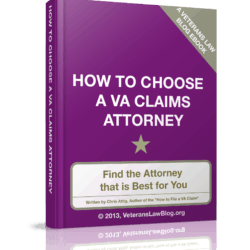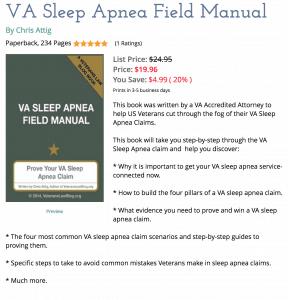When it comes to Veterans like you who are trying to improve your VA Claim, this is a pretty big question: What good is a Swiss Army knife in your pocket if you don’t – or can’t – use it?
Likewise, what good is the “law” if you can’t use it?
Understand it?
Improve your VA Claim by USING the law?
That is one of the original questions I asked when I started learning Veterans Law back in 2007. I read so many Court cases that were so thick with cites to other cases, use of what I call “$100 Lawyer Words“, that I very quickly came to realize a couple of things.
First, I realized that Court decisions – even the single judge and non-precedential decisions – were LOADED with guidance on how Veterans could improve their VA Claims and Appeals.
Second, I realized that this information was largely INACCESSIBLE to Veterans without a translation from “lawyer-speak” to “human-speak”.
These 2 questions shape how I talk about Case Law – from the Veterans Court or anywhere else.
Over the years (the Veterans Law Blog has been published since 2007, and has over 1,000 posts, several full-length video training courses and several eBooks), the VLB has posted reviews of cases from the Board of Veterans Appeals (BVA), the Court of Appeals for Veterans Claims (CAVC, Veterans Court), and the Federal Circuit Court of Appeals. (Click here to learn how all these boards and courts fit together in the VA Claims Process)
My goal, in each post, is to show you that cases are more than just one-liners about a particular rule of law. These cases can teach the savvy veteran how to improve their VA Claim or Appeal.
Whenever I write a post about a case from the Veterans Court or the Federal Circuit, I am going to distill the lessons-learned from the case that I discuss, and how you can USE those lessons to make your claim better.
Here are the 2 questions I try to answer in any CAVC Case Review:
- What is the Court saying – in plain English – in this case and why is it important to Veterans like you?
- How can you use the Court’s decsion to improve your own VA Claim or Appeal.
I’m going to share with you a few examples of how I review Court cases on the Veterans Law Blog – these are not the only 10 court cases, but some of the more popular case reviews on the VLB.
Here are 10 Court Cases that Teach Veterans How to Improve Their VA Claims and Appeals.
Understanding Veterans Court cases – and how to apply them to improve your claim or appeal – is such a critical step that it is Step 3 of my 8 Steps to Improve Your VA Claim or Appeal.
Without further delay, here are 10 Veterans Court and Federal Circuit Court cases that help you improve your VA Claim or Appeal.
#10: Challenging the Inadequate VA C&P Exam.
Bad Medicine: 6 Ways to Challenge VA C&P Results.
The Court’s non-precedential decision in the Maughan case teaches Veterans how to challenge an inadequate Compensation and Pension Exam.
This Federal Circuit Court decision underscores the need to get your VA C-File – NOW!
#9: The Importance of having your VA C-File.
This case illustrates the importance of the VA C-File. Because the VA played “hide-and-seek” with this Veteran’s C-File, he had to suffer through several years of appeals to the Court before he could argue for REAL relief.
Oh – and don’t forget to Get your C-File NOW!
#8: Upsetting the “Apple Cart” in Extra-schedular TDIU Claims.
This non-precedential Veterans Court opinion upset the Apple Cart and opened a world of new possibilities for Extra Schedular IU Claims.
For years, the VA has been denying Extra-Schedular IU Claims. Turns out, they’ve been using the WRONG criteria to deny them. This non-precedential Court case shows us the RIGHT criteria to use.
You can get some practical tools for your TDIU claim in the VA TDIU Field Manual.
#7: Service Connecting Drug and Alcohol Abuse.
Allen v. Principi shows us 3 Ways to Service Connect Drug or Alcohol Abuse.
When the VA sees drugs/alcohol in a Veteran’s claim, it is almost a “sure-thing” that they’ll deny it. But the Allen v. Principi case shows Veterans 3 Ways to avoid this outcome.
#6: 10 Court Cases Every Veteran Should Know.
10 Veterans Court Cases EVERY Veteran Needs to Know.
If you are handling your own appeal, you WILL need to know most, if not all, of these Court Cases.
#5: Can Medication reduce your VA Impairment Rating?
Jones v. Shinseki shows Veterans how to start to protect their rating if the VA wants to reduce it because you are taking medicine.
Do you know what to do if you get a letter from the VA saying “We’re cutting your benefits because the drugs you take make you less disabled”?
This post puts you on the right path to fighting such a letter.
#4: El Amin – a “Gold Mine” for Savvy Veterans.
3 Big Lessons the Veterans Court teaches in the El Amin case.
The El Amin case is a GOLD mine of “how-to” for the savvy Veteran. In this post, I show you 3 take-away points that might just help you improve your VA claim or appeal.
#3: Formalizing the Informal Claim.
What you NEED to Know about Formalizing an Informal Claim for Benefits.
Informal claims would be completely unnecessary if processing times on claims – and appeals – was anywhere on the spectrum of reasonableness. But since it can take 5-8 years to win your claim, it is VITAL that Veterans know how to formalize an informal claim.
Otherwise, they could be leaving a lot of benefits on the table.
#2: The VA Hasn’t Earned the Right to a Presumption of Regularity.
In this post, I will teach you how to Fight Back when the VA says they “followed a regular procedure” in your claim.
When the VA tries to defend itself against your allegation that you never received your decision, or notice of a C&P, or some other key document, it will invariably argue that it follows a “regular procedure”.
Here’s how to challenge that argument, and hold the VAs feet to the fire.
NOTE: This post has pulled out of circulation temporarily while I update the law – until I repost it, click here to learn what a legal presumption is.
#1: Finding Error in REALLY OLD cases: the VA Routinely Misapplies the Presumption of Soundness.
How to Keep the VA from tripping you up on the issue of “pre-existing” conditions.
For YEARS, the VA improperly shifted the burden of proof in the Presumption of Soundness to the Veteran. The Horn case told the VA to “get it right”.
Nearly half a decade after the Horn case, and I still see half a dozen VA Ratings decisions a month – AT LEAST – where the VA is still getting the law wrong. The situation continues to be so bad that the Veterans Court has again scolded the VA for continuing to get this wrong, and in this post, I will show you how to use another Court case to build a CUE claim when the VA fails to properly apply the presumption of soundness and you didn’t know to appeal this incorrect decision.
(In their defense, the bureaucratic reliance on templates and forms forces them to get the law wrong about nearly everything – check out this example).
If the VA denies service connection on the grounds that your medical condition pre-existed service, you need to get VERY comfortable with the Horn decision.
Help me make the Veterans Law Blog BETTER!!
If you could wave a magic wand, and learn one thing that would make your VA Claim better, what would it be?
Tell me using the form on this page, and I will scour the Veterans Court cases looking for an answer.






